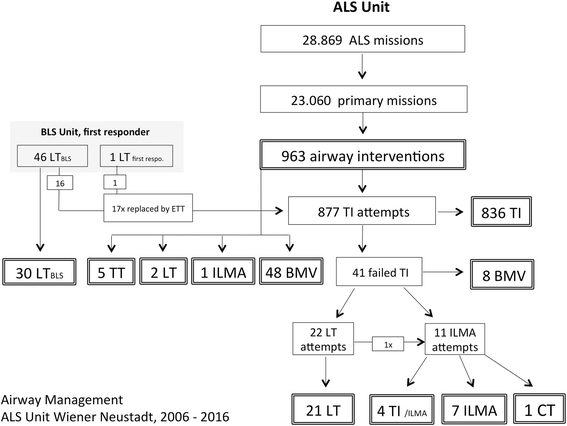In-hospital airway management training for non-anesthesiologist EMS physicians: a descriptive quality control study
- PMID: 28441963
- PMCID: PMC5405543
- DOI: 10.1186/s13049-017-0386-9
In-hospital airway management training for non-anesthesiologist EMS physicians: a descriptive quality control study
Abstract
Background: Pre-hospital airway management is a major challenge for emergency medical service (EMS) personnel. Despite convincing evidence that the rescuer's qualifications determine efficacy of tracheal intubation, in-hospital airway management training is not mandatory in Austria, and often neglected. Thus we sought to prove that airway management competence of EMS physicians can be established and maintained by a tailored training program.
Methods: In this descriptive quality control study we retrospectively evaluated all in- and pre-hospital airway cases managed by EMS physicians who underwent a structured in-hospital training program in anesthesia at General Hospital Wiener Neustadt. Data was obtained from electronic anesthesia and EMS documentation systems.
Results: From 2006 to 2016, 32 EMS physicians with 3-year post-graduate education, but without any prior experience in anesthesia were trained. Airway management proficiency was imparted in three steps: initial training, followed by an ongoing practice schedule in the operating room (OR). Median and interquartile range of number of in-hospital tracheal intubations (TIs) vs. use of supra-glottic airway devices (SGA) were 33.5 (27.5-42.5) vs. 19.0 (15.0-27.0) during initial training; 62.0 (41.8-86.5) vs. 33.5 (18.0-54.5) during the first, and 64.0 (34.5-93.8) vs. 27 (12.5-56.0) during the second year. Pre-hospitaly, every physician performed 9.0 (5.0-14.8) TIs vs. 0.0 (0.0-0.0) SGA cases during the first, and 9.0 (7.0-13.8) TIs vs. 0.0 (0.0-0.3) SGA during the second year. Use of an SGA was mandatory when TI failed after the second attempt, thus accounting for a total of 33 cases. In 8 cases, both TI and SGA failed, but bag mask ventilation was successfully performed. No critical events related to airway management were noted and overall success rate for TI with a max of 2 attempts was 95.3%.
Discussion: Number of TIs per EMS physician is low in the pre-hospital setting. A training concept that assures an additional 60+ TIs per year appears to minimize failure rates. Thus, a fixed amount of working days in anesthesia seems crucial to maintain proficiency. CONCLUSIONS: In-hospital training programs are mandatory for non-anesthetist EMS physicians to gain competence in airway management and emergency anesthesia.Our results might be helpful when discussing the need for regulation and financing with the authorities.
Keywords: Airway management; Difficult airway algorithm; Emergency anesthesia; Emergency physician; Quality control study; Tracheal intubation; Training.
Figures
Similar articles
-
Role of anesthesiology curriculum in improving bag-mask ventilation and intubation success rates of emergency medicine residents: a prospective descriptive study.BMC Emerg Med. 2011 Jun 16;11:8. doi: 10.1186/1471-227X-11-8. BMC Emerg Med. 2011. PMID: 21676271 Free PMC article.
-
Success rates of pre-hospital difficult airway management: a quality control study evaluating an in-hospital training program.Int J Emerg Med. 2018 Mar 16;11(1):19. doi: 10.1186/s12245-018-0178-7. Int J Emerg Med. 2018. PMID: 29549460 Free PMC article.
-
Pre-hospital airway management by non-physicians in Northern Finland -- a cross-sectional survey.Acta Anaesthesiol Scand. 2013 May;57(5):654-9. doi: 10.1111/aas.12101. Epub 2013 Mar 15. Acta Anaesthesiol Scand. 2013. PMID: 23496058
-
[Emergency anesthesia, airway management and ventilation in major trauma. Background and key messages of the interdisciplinary S3 guidelines for major trauma patients].Anaesthesist. 2011 Nov;60(11):1027-40. doi: 10.1007/s00101-011-1957-1. Anaesthesist. 2011. PMID: 22089890 Review. German.
-
[Reform of emergency physician training in Austria : Finally up to date?].Anaesthesist. 2018 Feb;67(2):135-143. doi: 10.1007/s00101-017-0387-0. Anaesthesist. 2018. PMID: 29209788 Review. German.
Cited by
-
Comparing the McGrath Mac Video Laryngoscope and Direct Laryngoscopy for Prehospital Emergency Intubation in Air Rescue Patients: A Multicenter, Randomized, Controlled Trial.Crit Care Med. 2019 Oct;47(10):1362-1370. doi: 10.1097/CCM.0000000000003918. Crit Care Med. 2019. PMID: 31389835 Free PMC article. Clinical Trial.
-
[Preclinical emergency anesthesia : A current state analysis from 2015-2017].Anaesthesist. 2019 May;68(5):270-281. doi: 10.1007/s00101-019-0562-6. Epub 2019 Mar 18. Anaesthesist. 2019. PMID: 30887074 German.
-
Comparison of the angle deviation of the nose line to the mentum and Mallampati test in predicting the difficult airway before anesthesia.J Family Med Prim Care. 2023 Jan;12(1):27-31. doi: 10.4103/jfmpc.jfmpc_2151_21. Epub 2023 Feb 15. J Family Med Prim Care. 2023. PMID: 37025243 Free PMC article.
-
The Anesthesiologist's Role in Teaching Airway Management to Nonanesthesiologists: Who, Where, and How.Adv Anesth. 2020 Dec;38:131-156. doi: 10.1016/j.aan.2020.08.002. Epub 2020 Oct 5. Adv Anesth. 2020. PMID: 34106831 Free PMC article. Review. No abstract available.
-
Analysis of endotracheal intubation-related judicial precedents in South Korea.Korean J Anesthesiol. 2021 Dec;74(6):506-513. doi: 10.4097/kja.21020. Epub 2021 Mar 25. Korean J Anesthesiol. 2021. PMID: 33761583 Free PMC article.
References
-
- European Case Law Identifier (ECLI) ECLI:AT: OGH0002:2016:0090OB00076.15I.0225.000
MeSH terms
LinkOut - more resources
Full Text Sources
Other Literature Sources


